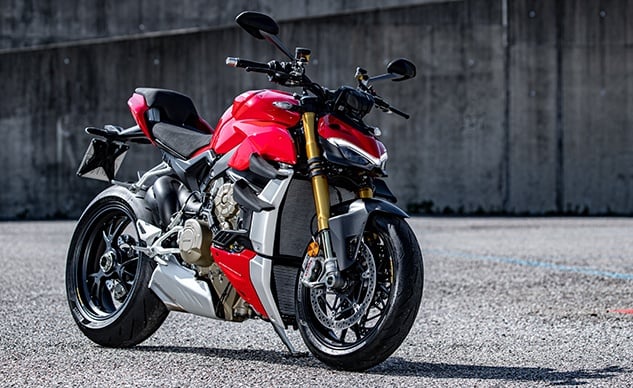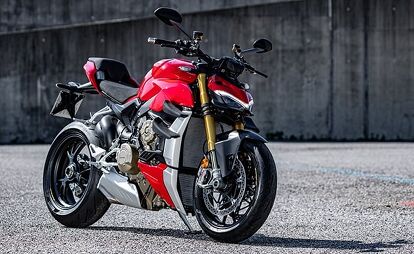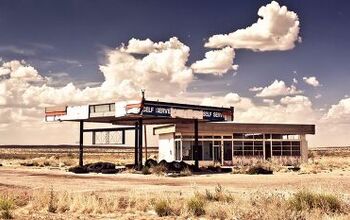8 Things You Need To Know About The 2020 Ducati Streetfighter V4

Some facts about the Streetfighter V4 from the people who made it
Poor Ducati. It seems as though the mystical powers that be simply have something against its new model, the Streetfighter V4. After all the hype surrounding a naked version of the mighty Panigale V4, nothing has gone to plan. First was the death of Carlin Dunne while en route to a commanding victory at the Pikes Peak hill climb, then came the cancellation of the international press intro for the SF V4 at the Ascari Circuit in Spain due to the Coronavirus pandemic.
Nonetheless, as the saying goes, the show must go on and Ducati is doing its best to make lemonade out of lemons; holding a livestream presentation for the Streetfighter. In it, lead designer Jeremy Faraud explained the concept behind the style of the Streetfighter. After, Ducati’s lead test rider Alessandro Valia – quite possibly the fastest factory test rider out there – took a deep dive into the technical aspects of the Streetfighter.
Getting a peek behind the curtain, so to speak, to learn about a motorcycle from the people who actually designed, engineered, tested, and ultimately made it is always revealing. This Streetfighter live stream, while definitely different than the norm, left us with a few key takeaways. Here, then, are 8 Things You Need To Know about the 2020 Ducati Streetfighter V4. Once the world has recovered from this unprecedented Coronavirus pandemic and opened its doors again, we can’t wait to actually ride the Streetfighter and see for ourselves if the hype is warranted. When we do, we’ll be sure to tell you our thoughts. Until then, read on to learn more about one of the most anticipated bikes of the year.
Designed After The Joker
As Faraud put it, the design inspiration for the Streetfighter came from the Joker – yes, the one from Batman – because of his split personalities. In the Streetfighter’s case, this is a machine that’s calm and elegant on the street, but can get wild and aggressive on the racetrack. Faraud explained how the angled LED daytime running lights form the angry eyes while the black space below occupying the air intakes give an aggressive, Joker-like appearance. From the side view the Streetfighter had to clearly resemble a naked bike, but with obvious inspiration from the Panigale V4. Exposing the V4 engine and front frame was the obvious first start, then the remaining bodywork takes the same angular shapes and lines as the Panigale V4. Faraud likes to think of the Streetfighter as having a floating body above the mechanical components.
F1-Inspired
Moving hot air is hard to do on a bike with minimal fairings, but the Ducati Streetfighter incorporates F1-inspired extractors behind the radiator to move hot air away from the rider. It also has a secondary benefit as the mounting points for the wings. More on that in a moment.
Longer than the Panigale
Since the Streetfighter is meant to be more relaxed and (slightly) easier to manage than the Panigale, its wheelbase is extended compared to Panigale 0.5-inch (15mm), making it 58.3 inches. This should reduce the tendency to wheelie and make the Streetfighter a little more stable.
Wings!
If the Panigale V4 sets the bar with one set of wings, then the Streetfighter ups the ante with two! The biplane wings are mainly the result of wanting to reduce the width of the bike compared to the huge wings seen on the Panigale. Meanwhile none of the downforce was lost in the process. Ducati says there’s already 4.4 lbs (2 kg) of downforce at 31 mph (50 kph), while 168 mph (270 kph) equals 62 lbs (28 kg) of downforce. Interestingly, Ducati claims the downforce distribution, in this case, is 44 lbs (20 kg) on the front and 18 lbs (8 kg) on the rear. The purpose is to add mechanical grip, reducing the tendency to wheelie, while adding stability at high speed, including those first moments when you get on the brakes. The wings also increase airflow through the water and oil radiators by 2% and 10% respectively.
A 200-hp Nakedbike?!
We all know the Streetfighter V4 shares the same 1103cc Stradale V4 engine as the Panigale, but it’s still crazy enough to warrant another look. This 90º, 1103cc V4 features Ducati’s tried and true desmodromic valve actuation and stays true to Ducati’s V-Twin heritage by essentially coupling each bank of cylinders together. Cylinders 1 and 2 fire 90º apart, then the crank rotates another 200º before cylinders 3 and 4 fire, 90º apart. The result is 208 hp, slightly down from the Panigale’s 214 claimed horses, though still a monstrous amount. Ducati even says 70% of the bike’s torque is available from 4000 rpm. Because there’s so much power on tap, power is actually curtailed to certain degrees in the first three gears, before full punch is on tap from fourth gear on. A shorter final drive ratio vs. the Panigale V4 will give the rider the feeling of a more powerful launch when the throttle is twisted.
Panigale V4 Electronics
A superbike sans fairings, the Streetfighter promises to be a beast for the reasons described above. Thankfully, the Streetfighter will also come equipped with the same electronics package as the Panigale V4, all centering around the Bosch 6-axis IMU. That means:
- ABS Cornering EVO
- Ducati Traction Control (DTC) EVO 2
- Ducati Slide Control (DSC)
- Ducati Wheelie Control (DWC) EVO
- Ducati Power Launch (DPL)
- Ducati Quick Shift up/down (DQS) EVO 2
- Engine Brake Control (EBC) EVO
- Ducati Electronic Suspension (DES) EVO (S model only)
As I noted in my Panigale V4 review, this latest generation of Ducati electronics is some of the best in the business, a direct result of Ducati’s racing division, Ducati Corse, working in conjunction with the production side to fine tune the software and algorithms controlling the rider aids. For example, DTC EVO2 has been refined to the point you can hardly feel any oscillation from the rear when the tire spins and the system kicks in. Also, the throttle mapping will actually reduce revs if it detects slip during neutral throttle. Typically, if you’re maintaining neutral throttle and the rear wheel slips revs will rise, making an already sketchy situation even harder to control.
A Focus On Rider Comfort
A Panigale for those who don’t want to commit themselves to the Panigale’s ergonomics, the Streetfighter relaxes things a little. It starts with the bars, which raise the rider up, ends at the pegs, which are 24mm lower than the Panigale, and meets in the middle with a seat that has 60mm of foam. This comfort comes at the expense of short people, as the SF’s 33.3-inch seat height might deter the vertically challenged.
Light As A Feather
If Ducati’s stated curb weight is to be believed, then the Streetfighter V4 has a leg up on its main rival. Ducati says the Streetfighter weighs in at 439 lbs full of gas (392.4 lbs dry) – and this is for the S model with Öhlins electronic suspension! The standard model is 443 lbs. Divide that by the claimed 208 hp, and you have a power-to-weight ratio of 2.1 lbs per horse! Taking a look at the Streetfighter’s main competition, the Aprilia Tuono V4 1100 Factory, it’s stated curb weight is 460 lbs. Divided by its claimed power rating of 175 hp, and you have a power-to-weight ratio of 2.6:1.
Of course, now that everyone’s appetites have been thoroughly whetted, the only thing left to do is ride the thing.

Troy's been riding motorcycles and writing about them since 2006, getting his start at Rider Magazine. From there, he moved to Sport Rider Magazine before finally landing at Motorcycle.com in 2011. A lifelong gearhead who didn't fully immerse himself in motorcycles until his teenage years, Troy's interests have always been in technology, performance, and going fast. Naturally, racing was the perfect avenue to combine all three. Troy has been racing nearly as long as he's been riding and has competed at the AMA national level. He's also won multiple club races throughout the country, culminating in a Utah Sport Bike Association championship in 2011. He has been invited as a guest instructor for the Yamaha Champions Riding School, and when he's not out riding, he's either wrenching on bikes or watching MotoGP.
More by Troy Siahaan





























































































































































































Comments
Join the conversation
Did riders back in the day achieve a better lean angle, or was the Earth just horizontal?
Ducati makes beautiful bikes. I still think the most streetable naked is the Super Duke. All it’s torque and horsepower below 9500 rpm. It’s V2 is rough not smooth as it is an angry beast.